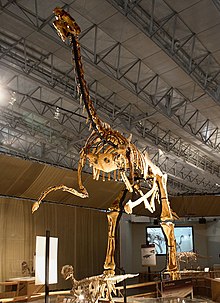| Gigantoraptor Temporal range: Late Cretaceous,
~ | |
|---|---|

| |
| Mounted reconstructed skeleton of Gigantoraptor in Japan | |
| Scientific classification | |
| Domain: | Eukaryota |
| Kingdom: | Animalia |
| Phylum: | Chordata |
| Clade: | Dinosauria |
| Clade: | Saurischia |
| Clade: | Theropoda |
| Superfamily: | †Caenagnathoidea |
| Family: | †Caenagnathidae |
| Genus: | †Gigantoraptor Xu et al., 2007 |
| Type species | |
| †Gigantoraptor erlianensis Xu et al., 2007
| |
Gigantoraptor (lit. 'giant thief') is a genus of large oviraptorosaur dinosaur that lived in Asia during the Late Cretaceous period. It is known from the Iren Dabasu Formation of Inner Mongolia, where the first remains were found in 2005.
Gigantoraptor was the largest-known oviraptorosaur, reaching 8 metres (26 ft) in length and 2 metric tons (2.2 short tons) in body mass. It had an extensively pneumatized vertebral column and elongated arms and legs. Both femur and tibia measured over 1 m (3.3 ft) in length, an unusual trait among giant theropods. The lower jaws were toothless and ended in a keratinous beak, as seen in other oviraptorosaurs. Though several oviraptorosaur species are known to have developed a full coat of feathers, Gigantoraptor, due to its size, could have lost some of this integument.
The genus is classified as an oviraptorosaurian dinosaur, a group of generally small feathered animals. Though it was originally found to represent a basal oviraptorid, subsequent analyses have shown it to be a caenagnathid. It was a giant, ground-dwelling bipedal omnivore or herbivore with a shearing bite as indicated by the preserved mandible. The shape of its beak indicates a generalist diet with a potentially occasional carnivory. The holotype—and only known specimen—has been determined to represent a young adult that died at the age of 11, and it reached a young adulthood around 7 years of life. Such development indicates an accelerated growth compared to other larger theropods. The discovery and examination of large oviraptorosaur eggs, Macroelongatoolithus, indicates that large species such as Gigantoraptor built their nests with the center lacking eggs in order to avoid crushing.